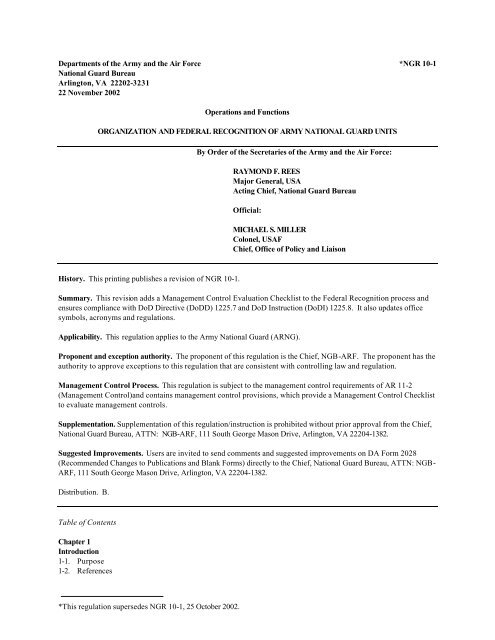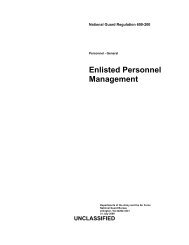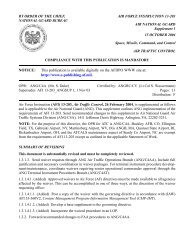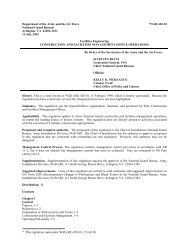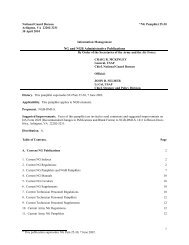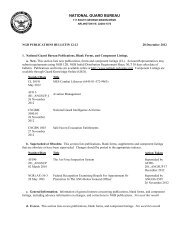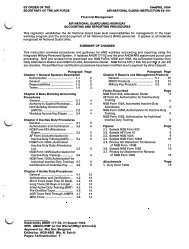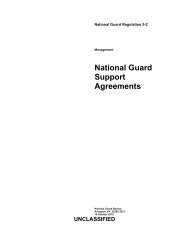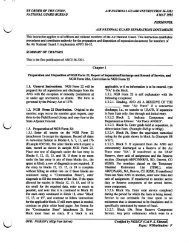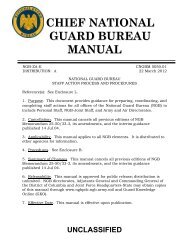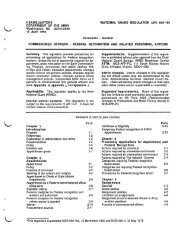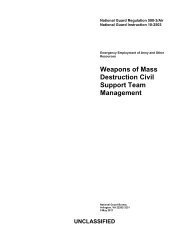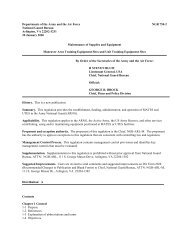NGR 10-1 - NGB Publications and Forms Library - U.S. Army
NGR 10-1 - NGB Publications and Forms Library - U.S. Army
NGR 10-1 - NGB Publications and Forms Library - U.S. Army
Create successful ePaper yourself
Turn your PDF publications into a flip-book with our unique Google optimized e-Paper software.
Departments of the <strong>Army</strong> <strong>and</strong> the Air Force *<strong>NGR</strong> <strong>10</strong>-1<br />
National Guard Bureau<br />
Arlington, VA 22202-3231<br />
22 November 2002<br />
Operations <strong>and</strong> Functions<br />
ORGANIZATION AND FEDERAL RECOGNITION OF ARMY NATIONAL GUARD UNITS<br />
By Order of the Secretaries of the <strong>Army</strong> <strong>and</strong> the Air Force:<br />
RAYMOND F. REES<br />
Major General, USA<br />
Acting Chief, National Guard Bureau<br />
Official:<br />
MICHAEL S. MILLER<br />
Colonel, USAF<br />
Chief, Office of Policy <strong>and</strong> Liaison<br />
History. This printing publishes a revision of <strong>NGR</strong> <strong>10</strong>-1.<br />
Summary. This revision adds a Management Control Evaluation Checklist to the Federal Recognition process <strong>and</strong><br />
ensures compliance with DoD Directive (DoDD) 1225.7 <strong>and</strong> DoD Instruction (DoDI) 1225.8. It also updates office<br />
symbols, acronyms <strong>and</strong> regulations.<br />
Applicability. This regulation applies to the <strong>Army</strong> National Guard (ARNG).<br />
Proponent <strong>and</strong> exception authority. The proponent of this regulation is the Chief, <strong>NGB</strong>-ARF. The proponent has the<br />
authority to approve exceptions to this regulation that are consistent with controlling law <strong>and</strong> regulation.<br />
Management Control Process. This regulation is subject to the management control requirements of AR 11-2<br />
(Management Control)<strong>and</strong> contains management control provisions, which provide a Management Control Checklist<br />
to evaluate management controls.<br />
Supplementation. Supplementation of this regulation/instruction is prohibited without prior approval from the Chief,<br />
National Guard Bureau, ATTN: <strong>NGB</strong>-ARF, 111 South George Mason Drive, Arlington, VA 22204-1382.<br />
Suggested Improvements. Users are invited to send comments <strong>and</strong> suggested improvements on DA Form 2028<br />
(Recommended Changes to <strong>Publications</strong> <strong>and</strong> Blank <strong>Forms</strong>) directly to the Chief, National Guard Bureau, ATTN: <strong>NGB</strong>-<br />
ARF, 111 South George Mason Drive, Arlington, VA 22204-1382.<br />
Distribution. B.<br />
Table of Contents<br />
Chapter 1<br />
Introduction<br />
1-1. Purpose<br />
1-2. References<br />
*This regulation supersedes <strong>NGR</strong> <strong>10</strong>-1, 25 October 2002.
<strong>NGR</strong> <strong>10</strong>-1 22 November 2002<br />
1-3. Explanation of abbreviations <strong>and</strong> terms<br />
1-4. Responsibilities<br />
Chapter 2<br />
Procedural Information<br />
2-1. General<br />
2-2. Allotment of Units<br />
2-3. Designation of Units<br />
2-4. Unit Identification Codes<br />
2-5. Types of UICs<br />
2-6. Federal Recognition of Units<br />
2-7. Authorization<br />
2-8. Unit St<strong>and</strong>ards<br />
2-9. Determination of Unit Status<br />
2-<strong>10</strong>. Units Failing to Maintain Unit St<strong>and</strong>ards<br />
2-11. Requests for Organization, Reorganization, Redesignation, Consolidation, <strong>and</strong> Conversion<br />
2-12. Change of Station<br />
2-13. Attachment of a Unit<br />
2-14. Return of <strong>Army</strong> National Guard United States (ARNGUS) Units to State Control<br />
2-15. Concept Plans<br />
2-16. Force Management Division Planning Shell for Concept Plans<br />
2-17. Multi Component Documentation<br />
Appendix A<br />
References<br />
Appendix B<br />
Stationing Plans<br />
Appendix C<br />
Force Management Division Planning Shell<br />
Appendix D<br />
Management Control Evaluation Process<br />
Appendix E<br />
Unit Identification Code (UIC) Policy, Process, <strong>and</strong> Procedures<br />
Glossary<br />
2
22 November 2002 <strong>NGR</strong> <strong>10</strong>-1<br />
Chapter 1<br />
Introduction<br />
1-1. Purpose<br />
This regulation prescribes policies <strong>and</strong> procedures for the organization, change of status, Federal Recognition, <strong>and</strong><br />
minimum st<strong>and</strong>ards of <strong>Army</strong> National Guard (ARNG) units.<br />
1-2. References<br />
Required publications, related publications, prescribed forms <strong>and</strong> referenced forms are listed in Appendix A.<br />
1-3. Explanation of abbreviations <strong>and</strong> terms.<br />
Abbreviations <strong>and</strong> special terms used in this regulation are explained in the glossary.<br />
1-4. Responsibilities<br />
a. The Chief, National Guard Bureau (C<strong>NGB</strong>) will establish policies <strong>and</strong> procedures for:<br />
(1) Organization<br />
(2) Change in status<br />
(3) Extending Federal Recognition<br />
(4) Withdrawal of Federal Recognition<br />
(5) Extending temporary Federal Recognition<br />
(6) Withdrawal of temporary Federal Recognition<br />
(7) Unit st<strong>and</strong>ards<br />
(8) OA<br />
b. The State Adjutant General (AG) will:<br />
(1) Prepare <strong>and</strong> submit concept plans.<br />
(2) Comply with DoDD 1225.7 <strong>and</strong> DoDI 1225.8, prior to stationing ARNG units. The State Adjutant General<br />
will review the manpower potential of the area, <strong>and</strong> if appropriate, prepare, sign, <strong>and</strong> submit the following<br />
demographics certification as required by DoDI 1225.8, Enclosure 6, paragraph E6.3.<br />
“The Reserve manpower potential to meet <strong>and</strong> maintain authorized officer <strong>and</strong> enlisted strengths of all Reserve units<br />
in the areas where units are to be located has been reviewed, in accordance with the procedures described in DoDD<br />
1225.7 <strong>and</strong> DoDI 1225.8. It has been determined, in coordination with the other Military Departments having Reserve<br />
units in the area, that the number of Reserve component units presently located in the area, <strong>and</strong> those units having<br />
been allocated to this area for future activation, is not, <strong>and</strong> shall not be larger than the number that reasonably may<br />
be maintained at authorized strength.”<br />
3
<strong>NGR</strong> <strong>10</strong>-1 22 November 2002<br />
(3) Submit a statement of adequacy, to meet <strong>and</strong> maintain authorized strengths, shall be included in the<br />
project justification for DD <strong>Forms</strong> 1390/91 (Military Construction) <strong>and</strong> also in Stationing Plans submitted to C<strong>NGB</strong><br />
even if construction is not involved.<br />
(4) Complete the procedures as required in Enclosures 1 through 6 of DoDI 1225.8. A statement from the<br />
State Adjutant General ensuring that Enclosures 1 through 6 have been complied with will be submitted as an<br />
enclosure to the stationing plan.<br />
(5) Submit stationing plans for units requiring organization or change in status.<br />
(6) Submit <strong>NGB</strong> Form 113 (Report of Inspection for Federal Recognition).<br />
(7) Determine the unit’s status regarding unit st<strong>and</strong>ards, <strong>and</strong> report units failing to maintain unit st<strong>and</strong>ards.<br />
(8) Submit state plans on units returning from active federal service (if returning to a location other than<br />
from where they were originally located).<br />
(9) Prepare <strong>and</strong> distribute permanent orders.<br />
Chapter 2<br />
Procedural Information<br />
2-1. General<br />
a. Equal Opportunity. In order for a unit to qualify for initial Federal Recognition or to maintain its federally<br />
recognized status, the enlistment <strong>and</strong> appointment of applicants, assignment, promotion, or other personnel actions<br />
affecting its soldiers shall be without regard to the race, color, religion, gender (except for assignment limitations<br />
prescribed by regulation) or national origin of the applicant or soldier.<br />
b. Organization of Units<br />
(1) Except as otherwise specifically provided, the organization of the ARNG <strong>and</strong> the composition of all its<br />
units shall be the same as that which is, or may hereafter be, prescribed for the Active <strong>Army</strong>, subject in time of peace<br />
to such general exceptions as may be authorized by the Secretary of the <strong>Army</strong> (Title <strong>10</strong> United States Code (USC)<br />
<strong>10</strong>503 <strong>and</strong> Title 32 USC Section <strong>10</strong>4).<br />
(2) Unless otherwise directed by C<strong>NGB</strong>, an entire MTOE or TDA unit will be organized within a community.<br />
When the community cannot support a complete unit, C<strong>NGB</strong> may consider a request for a subunit to be organized<br />
separately, creating a split unit within that state. All adjustments to strength elements of a split organization must be<br />
approved by the State AG <strong>and</strong> published in permanent orders. Two copies of Permanent Orders effecting initial <strong>and</strong><br />
subsequent strength changes will be sent to <strong>NGB</strong>-ARF <strong>and</strong> United States <strong>Army</strong> Forces Comm<strong>and</strong> (FORSCOM) or<br />
overseas comm<strong>and</strong>er.<br />
(3) Units split between states (e.g. an engineer company located in one state, with the balance of the<br />
battalion located in another state) must be fully justified, planned, staffed, coordinated <strong>and</strong> programmed. Each state<br />
is responsible to ensure that the unit is provided copies of the appropriate MTOE.<br />
(4) Multiple Component Units (MCUs), split between components of the U.S. <strong>Army</strong>, must be nominated by<br />
DARNG, justified, planned, staffed, coordinated, <strong>and</strong> programmed in accordance with HQDA multiple component<br />
policy <strong>and</strong> appropriate regulations. Each state is responsible to ensure that the unit is provided copies of the<br />
appropriate MTOE.<br />
4
22 November 2002 <strong>NGR</strong> <strong>10</strong>-1<br />
2-2. Allotment of Units<br />
a. Allotment to a state comprises all units allocated to <strong>and</strong> accepted by the Governor of that state for<br />
organization under appropriate authorization documents.<br />
b. No change in the branch, organization, or allotment of a unit located entirely within a state may be made<br />
without the approval of the Governor of that state under Title <strong>10</strong> USC Section 18238, <strong>and</strong> Title 32 USC Section <strong>10</strong>4.<br />
c. An organization of the National Guard, the members of which having received compensation from the United<br />
States as members of the National Guard, may not be disb<strong>and</strong>ed by the state without the consent of the President of<br />
the United States, or the Secretary of the <strong>Army</strong> acting for the President, under Title 32 USC, Section <strong>10</strong>4.<br />
2-3. Designation of Units ARNG units will be designated in Organizational Authority (OA) letters issued by C<strong>NGB</strong>.<br />
These designations will conform to HQDA policy, procedures, <strong>and</strong> AR 220-5. Normally, the designation of TOE units<br />
will be prescribed by the unit designation appearing under the title of the appropriate MTOE. However, the official<br />
designation will be the designation contained in the OA directing the change in status of the unit.<br />
a. When further identification of the unit type is desirable, additional descriptive words may be added<br />
parenthetically as approved by HQDA. When the designation includes a parenthetical identification, that portion<br />
not in parenthesis is the official designation. Redesignation of a unit is not required where a change is made in the<br />
parenthetical identification. For example, 222 nd Transportation Company (Lt Trk) to 222 nd Transportation Company<br />
(Lt-Med Trk).<br />
b. Chief of Military History controls <strong>and</strong> issues all names <strong>and</strong> numbers used in ARNG unit designations. C<strong>NGB</strong><br />
officially assigns numbers for units of the ARNG <strong>and</strong> prepares an OA.<br />
c. Units within parent regiments established under the US <strong>Army</strong> Regimental System (USARS) will have, within<br />
each parent regiment, a variable number of active units depending upon the <strong>Army</strong> Force Program. The regiment<br />
(except armored cavalry regiment) will be a family of units bearing the regimental name. Regimental designations are<br />
maintained primarily for historic <strong>and</strong> morale purposes. Except in the case of armored cavalry regiments, which contain<br />
a tactical regimental headquarters, units sharing the same regimental designation do not necessarily share a comm<strong>and</strong><br />
or supply relationship. When there are no composite units of a USARS regiment in the ARNG troop structure, the<br />
regiment will be inactivated <strong>and</strong> returned to control of C<strong>NGB</strong> (<strong>NGB</strong>-PAI-H).<br />
2-4. Unit Identification Codes (UICs) The UIC is a six-character alphanumeric code that uniquely identifies an<br />
organization (CJCSM 3150.02).<br />
a. The UIC consists of three data elements <strong>and</strong> is structured as follows:<br />
(1) The first position indicates service designator. “W” is for all <strong>Army</strong> units.<br />
(2) Positions 2, 3 & 4 equal parent organization designator.<br />
(3) Positions 5 & 6 equal descriptive designator. These two positions further define or break out<br />
organizational elements belonging to that parent organization.<br />
b. The letters I or O are never used.<br />
2-5. Types of Unit Identification Codes<br />
a. Parent UIC. Each parent unit MTOE <strong>and</strong> TDA will be assigned a unique UIC. The recording of an MTOE <strong>and</strong><br />
a TDA unit on the same authorization document is prohibited. A numbered organization of battalion or equivalent<br />
5
<strong>NGR</strong> <strong>10</strong>-1 22 November 2002<br />
level, or a company, battery, troop, or detachment that is not an organic element of a battalion or other parent<br />
organization; will always end with AA.<br />
b. Derivative UIC. Used to identify organic elements of an organizational element that is expressed in the<br />
organization structure or identifies a functional subordinate element of an organization. The first four characters of a<br />
derivative UIC must be the same as those of the parent UIC from which the organization was derived. Positions 5 <strong>and</strong><br />
6 will end with T0, T1, A0, A1, B0, B1, B2 etc.<br />
c. Augmentation UIC. A nonst<strong>and</strong>ard organization that augments an MTOE organization. A TDA<br />
augmentation to a parent MTOE will be documented with a derivative UIC of the parent unit such as WXXX99.<br />
Position 5 <strong>and</strong> 6 will end between 99 <strong>and</strong> 91.<br />
d. Carrier UIC. A carrier UIC is assigned to provide a means to assign personnel to <strong>and</strong> account for equipment<br />
in a unit until activation. When the HQDA Unit Identification Code Information Officer (UICIO) assigns a UIC for<br />
unit activation, a carrier UIC is also assigned. Both UICs are registered in the Chairman, Joint Chiefs of Staff Global<br />
Status of Resources <strong>and</strong> Training System (GSORTS). Upon activation of the MTOE unit, the Major <strong>Army</strong> Comm<strong>and</strong><br />
(MACOM) UICIO must delete the carrier UIC (AR 71-32).<br />
(1) The carrier UIC provided by HQDA for an approved active army or reserve component MTOE unit<br />
activation will normally have an effective date (EDATE) 1 year before the documented unit EDATE. Personnel <strong>and</strong><br />
equipment requisitions will cite the approved document as requisition authority <strong>and</strong> show the carrier UIC. On arrival<br />
at the location of the activating unit, personnel are assigned to <strong>and</strong> equipment is accounted for under the carrier UIC<br />
until the approved document's unit EDATE. The carrier UIC will be a two position code designed as "90" appearing<br />
in the fifth <strong>and</strong> sixth positions of the UIC code. If the proponent determines that the activation of the unit cannot be<br />
accommodated on the specified EDATE because of readiness considerations <strong>and</strong> a revised unit EDATE is approved<br />
by HQDA, the carrier UIC will continue in existence until the revised unit EDATE (AR 71-32).<br />
(2) Reorganizations <strong>and</strong> conversions will not receive a carrier UIC. However, the authority <strong>and</strong> time periods<br />
for requisitioning personnel <strong>and</strong> equipment are the same as stated above for new activations (AR 71-32).<br />
(3) A carrier UIC provides an organizational base for recruiting, transferring, <strong>and</strong> training of personnel<br />
assigned to the new unit within the guidelines established by <strong>NGB</strong> (AR 71-32).<br />
(4) For equipment, submit requisitions per AR 700-120. (AR 71-32).<br />
(5) Authorized by Deputy Chief of Staff for Operations (DCSOPS), it enables a parent organization to recruit<br />
<strong>and</strong> train people when the EDATE of the organization is more than one year out. The first four digits will be the same<br />
as the parent UIC; positions 5 <strong>and</strong> 6 will always be 90.<br />
e. Notional UIC. Assigned by DA, <strong>and</strong> used to track a planned unit prior to the assignment of a parent UIC. It<br />
begins with a G <strong>and</strong> then five numbers (i.e. G12345).<br />
f. Multiple Component Unit UIC. The first four characters of the UIC must be the same as those of the parent<br />
UIC. The second position of the UIC will be N, denoting multiple component, regardless of the parent being <strong>Army</strong>,<br />
<strong>Army</strong> National Guard, or <strong>Army</strong> Reserve. If the fifth position of the UIC is G, it is designating an ARNG element of a<br />
unit.<br />
g. Mobilization UIC. UICs that are created for mobilization purposes are created <strong>and</strong> managed in the <strong>NGB</strong><br />
Readiness Division (<strong>NGB</strong>-ARR).<br />
h. Stock Record, Property Book, or Maintenance Account, Task Force/Exercise UICs. A suborganization UIC<br />
used to identify a stock record, property book, or maintenance account by using the appropriate logistics indicator<br />
code (LIC). Additional records of this type that need to be uniquely identified will be assigned a derivative UIC for<br />
the organization. The UIC will be the same first four digits as the STARC; the last two digits will be between 01<br />
6
22 November 2002 <strong>NGR</strong> <strong>10</strong>-1<br />
through 89. <strong>NGB</strong> Logistics Division (<strong>NGB</strong>-ARL) will authorize the property book or maintenance account UICs, <strong>and</strong><br />
<strong>NGB</strong>-ARF will provide the next available UIC(s) (<strong>NGR</strong> 600-200).<br />
2-6. Federal Recognition of Units<br />
a. Extending Federal Recognition (Title <strong>10</strong> USC, Section <strong>10</strong>503, <strong>and</strong> Title 32 USC, Section <strong>10</strong>5). C<strong>NGB</strong>, acting for<br />
the Secretary of the <strong>Army</strong>, will extend Federal Recognition to a unit based on a favorable <strong>NGB</strong> Form 113. If the<br />
inspection is conducted prior to the date of organization, then the date of organization becomes the date of Federal<br />
Recognition. Requests for Federal Recognition must refer to the OA number for the unit. Federal Recognition must<br />
be accomplished within 6 months of the date of organization. Failure to conduct the Federal Recognition inspection<br />
within this time period may result in the withdrawal of the allotment of the unit to the state.<br />
b. Inspection Criteria. Inspections will include, but will not be limited to the following:<br />
(1) The unit’s having been allocated <strong>and</strong> authorized to be organized.<br />
(2) The unit’s having been organized in accordance with appropriate authorization documents –<br />
MTOE/TDA.<br />
(3) The unit’s having attained an assigned strength of 25 percent of MTOE/TDA authorized strength of<br />
officers <strong>and</strong> warrant officers combined <strong>and</strong> <strong>10</strong> percent of MTOE/TDA authorized strength of enlisted personnel.<br />
Exceptions include:<br />
(a) Units with ten or more aviator positions in the MTOE/TDA authorized strength column must have<br />
attained an assigned strength of 15 percent of all officers <strong>and</strong> warrant officers combined.<br />
(b) For medical units, <strong>Army</strong> Medical Department personnel (except Medical Service Corps) will be<br />
excluded in computing strength requirements.<br />
(4) Members of the unit having been enlisted or appointed <strong>and</strong> assigned without regard to race, color,<br />
religion, gender, or national origin, <strong>and</strong> otherwise qualified in accordance with appropriate <strong>NGR</strong>s.<br />
(5) All individual personnel records being complete <strong>and</strong> available.<br />
(6) Storage facilities for federal property having been provided in a secure supply room or strong room vault<br />
(arms room) (the Construction <strong>and</strong> Facilities Management Officer or a qualified state engineer must certify that<br />
weapons, ammunition, <strong>and</strong> explosive storage room, building, or area meets the minimum required physical security<br />
st<strong>and</strong>ards in AR 190-11.<br />
(7) An adequate armory facility having been provided, which is suitable for at least temporary occupancy.<br />
(8) The community favoring organization <strong>and</strong> maintenance of the unit.<br />
c. Procedures to Obtain Federal Recognition as an ARNG unit.<br />
(1) Upon determination that the requirements for Federal Recognition can be met, the State AG requests the<br />
Senior <strong>Army</strong> Advisor to inspect the unit. If there is no Senior <strong>Army</strong> Advisor, the State AG may request an officer on<br />
active (Title <strong>10</strong>) serving as the State Inspector General to inspect the unit (Title <strong>10</strong> USC 12314).<br />
(2) The Senior <strong>Army</strong> Advisor inspects the designated unit <strong>and</strong> submits <strong>NGB</strong> Form 113 to the StateAG. The<br />
Senior <strong>Army</strong> Advisor (or State Inspector General) may delegate federal inspection responsibility to a commissioned<br />
officer assigned to his/her staff.<br />
7
<strong>NGR</strong> <strong>10</strong>-1 22 November 2002<br />
T.<br />
(3) The completed <strong>NGB</strong> Form 113 is endorsed by the StateAG <strong>and</strong> forwarded to C<strong>NGB</strong>, ATTN: <strong>NGB</strong>-ARF-<br />
(4) C<strong>NGB</strong>, upon approving <strong>NGB</strong> Form 113, extends Federal Recognition to the unit. OA granting Federal<br />
Recognition will be forwarded to the StateAG, FORSCOM, <strong>and</strong> Continental United States (CONUSA) or overseas<br />
comm<strong>and</strong>ers concerned.<br />
d. Date of Federal Recognition.<br />
(1) The date on which the unit was inspected <strong>and</strong> found satisfactory is the date of Federal Recognition, or<br />
the date of organization will become the date of Federal Recognition if the inspection was conducted prior to the unit<br />
organization date.<br />
(2) When there is a change of station, Federal Recognition remains with the unit if 50 percent or more of its<br />
personnel move with the unit. If over 50 percent of assigned personnel move with the unit <strong>and</strong> is substantiated by<br />
submission of DA Form 1379 (U.S. <strong>Army</strong> Reserve Components Unit Record of Reserve Training), Federal<br />
Recognition will remain with the unit regardless of distance moved. In addition, the lineage <strong>and</strong> honors associated<br />
with a unit will not be lost if over 50 percent of assigned personnel move with the unit.<br />
(3) Upon reorganization, redesignation, or conversion, Federal Recognition remains with the unit.<br />
(4) Upon consolidation of two or mo re units, the date of Federal Recognition will be the date of the unit that<br />
was first extended Federal Recognition.<br />
e. Withdrawal of Federal Recognition.<br />
(1) C<strong>NGB</strong>, acting for the Secretary of the <strong>Army</strong>, may withdraw Federal Recognition from a unit that fails to<br />
maintain the policies prescribed by law (Title <strong>10</strong> USC, Section <strong>10</strong>503, <strong>and</strong> Title 32 USC, Section <strong>10</strong>8).<br />
(2) When Federal Recognition is withdrawn from a unit, the personnel shall be transferred to other federally<br />
recognized units, to the Inactive <strong>Army</strong> National Guard, or to the Individual Ready Reserve under provision of AR<br />
135-91. Copies of state orders directing such action will be forwarded to the ARNG Personnel Division (<strong>NGB</strong>-ARH).<br />
(3) States/territories requesting the withdrawal of Federal Recognition of a unit, <strong>and</strong> not consolidating it<br />
with another unit for lineage <strong>and</strong> honors purposes, will lose all lineage <strong>and</strong> honors connected with such a unit.<br />
f. Temporary Federal Recognition. C<strong>NGB</strong>, acting for the Secretary of the <strong>Army</strong>, extends temporary Federal<br />
Recognition to a new unit that has been allotted to a state <strong>and</strong> to which a carrier UIC has been assigned in<br />
accordance with (IAW) AR 71-32. Temporary Federal Recognition will be extended for a specified period, normally<br />
not more than one year, but for however long a carrier UIC is in place. Extensions of temporary Federal Recognition<br />
beyond one year will be h<strong>and</strong>led on an individual basis. Applicants may be recruited <strong>and</strong> enlisted or appointed for<br />
vacancies in a unit that has been extended temporary Federal Recognition. They are eligible to participate in training,<br />
in pay status, <strong>and</strong> are eligible for participation in the incentive bonus program (AR 135-7). If within the specified<br />
period of Temporary Federal Recognition the unit is not granted permanent Federal Recognition, the Temporary<br />
Federal Recognition will be withdrawn <strong>and</strong> unit members reassigned or separated, as appropriate.<br />
2-7. Authorization<br />
a. General. Section I of the MTOE/TDA states the mission <strong>and</strong> organization of each unit. Section II states the<br />
required <strong>and</strong> authorized strengths of the unit by grade <strong>and</strong> military occupational specialty (MOS). Section III states<br />
the required <strong>and</strong> authorized equipment levels. Section IIIs equipment supplement (TDA only) states the required <strong>and</strong><br />
authorized supplement equipment levels for National Guard line item numbers (LINS).<br />
8
22 November 2002 <strong>NGR</strong> <strong>10</strong>-1<br />
b. Exceeding Authorizations.<br />
(1) Personnel. The <strong>NGB</strong> strength policy is published annually by <strong>NGB</strong>-ARH. This policy is the basis for<br />
exceeding the strength contained in the authorized column of the MTOE/TDA. Additional temporary TDA positions<br />
may also be authorized by <strong>NGB</strong> to achieve specific <strong>NGB</strong> objectives. These policies will be stated separately.<br />
(2) Equipment. Equipment will be requisitioned, maintained, <strong>and</strong> turned in IAW applicable policy.<br />
Requisitioning or maintaining other than the authorized quantities requires specific approval of <strong>NGB</strong>. Requisitions<br />
for equipment will be submitted no sooner than 365 days before the effective date of the unit’s authorization<br />
document IAW AR 7<strong>10</strong>-2.<br />
c. Programmed Changes. Upon receipt of an MTOE/TDA to be implemented on a specific date (EDATE), the<br />
state <strong>and</strong> unit will plan the necessary changes to improve unit resources <strong>and</strong> training levels. If an early or delayed<br />
implementation date is required, a written request with full justification for an EDATE change must be submitted to<br />
<strong>NGB</strong>-ARF for approval by the Director of Force Programs, HQDA, IAW HQDA Comm<strong>and</strong> Plan Process <strong>and</strong> AR 71-<br />
32.<br />
(1) Begin to recruit <strong>and</strong> train the personnel authorized by the new document up to one year before EDATE.<br />
For exceptionally long MOS-producing schools, <strong>NGB</strong> Training Division (<strong>NGB</strong>-ART) may authorize earlier recruitment<br />
<strong>and</strong> training.<br />
(2) At the beginning of the period (365 days prior to EDATE) as authorized by AR 7<strong>10</strong>-2, requisition new<br />
equipment authorizations, plan redistribution, or prepare to turn in equipment that will become excess.<br />
(3) Unit Status Reporting (USR). In accordance with AR 220-1, units will report against a new MTOE/TDA<br />
on the EDATE of the document or before the EDATE if, in the opinion of the comm<strong>and</strong>er, the unit is more like the<br />
new MTOE/TDA than the old <strong>and</strong> reporting early will not degrade the unit’s overall level. The state must submit a<br />
written request to <strong>NGB</strong>-ARR-R to report readiness against a future MTOE prior to submission of the record USR.<br />
Early implementation requires written approval from <strong>NGB</strong>-ARF <strong>and</strong> HQDA.<br />
(4) When the authorized strength of a unit is changed by the MTOE/TDA, assigned personnel no longer<br />
authorized may be retained for 1 year past the EDATE. Every effort must be made to retain or reassign personnel into<br />
authorized positions (<strong>NGR</strong> 600-200).<br />
2-8. Unit St<strong>and</strong>ards<br />
a. General. Units will be manned, equipped, <strong>and</strong> trained to accomplish their assigned mission.<br />
b. Reporting Units. It is <strong>NGB</strong>’s goal that all units have a unit status reporting numerical C-level under AR 220-1,<br />
equal to the authorized level of organization (ALO) of the unit. As a minimum, all MTOE units organized at ALO 3 or<br />
higher <strong>and</strong> TDA units reporting under AR 220-1 must achieve <strong>and</strong> maintain a unit resource level of C-3 by comparing<br />
each of the personnel, equipment, <strong>and</strong> training resource areas to MTOE requirements.<br />
c. Nonreporting Units. For TDA units not reporting under AR 220-1, there are no minimum st<strong>and</strong>ards. The unit<br />
should be manned <strong>and</strong> equipped with the minimum personnel <strong>and</strong> equipment required to accomplish its mission.<br />
Send requests to <strong>NGB</strong>-ARF to reduce the authorized personnel <strong>and</strong> equipment if they exceed the minimum required.<br />
d. Newly Organized or Converted Units. Units not given C-5 reporting authority must meet the C-3 level<br />
st<strong>and</strong>ard. Units given C-5 reporting authority will specify the milestones needed to achieve a C-3 level. These<br />
milestones must meet or exceed the following criteria unless other guidance is provided by <strong>NGB</strong>.<br />
(1) Within 20 percent of the requirements for C-3 resource level by the end of the first year.<br />
(2) Within <strong>10</strong> percent of the requirements for C-3 resource level by the end of the second year.<br />
9
<strong>NGR</strong> <strong>10</strong>-1 22 November 2002<br />
(3) By the end of the third year, MTOE units organized at ALO 3 or higher <strong>and</strong> TDA units reporting under<br />
AR 220-1 must achieve <strong>and</strong> maintain a unit resource level of C-3.<br />
2-9. Determination of Unit Status<br />
The unit st<strong>and</strong>ards specified in paragraph 2-8 will be implemented using unit status reports. The StateAG is<br />
responsible for reporting the status of units IAW AR 220-1.<br />
2-<strong>10</strong>. Units Failing to Maintain Unit St<strong>and</strong>ards<br />
a. When it is determined that a unit does not meet the st<strong>and</strong>ards specified in paragraph 11, the StateAG will take<br />
the following action:<br />
(1) For those units that meet or exceed minimum st<strong>and</strong>ards, but fail to achieve the <strong>NGB</strong> goal, the StateAG<br />
will take appropriate action, through the state readiness committee, to establish milestones as necessary for the unit<br />
to meet its goal. <strong>NGB</strong>-ARR may request reasons for low status level <strong>and</strong>/or actions being taken on a case-by-case<br />
basis.<br />
(2) For those units failing to meet minimum st<strong>and</strong>ards specified in paragraph 2-8, the StateAG, through the<br />
state readiness committee, will prepare <strong>and</strong> implement a corrective action plan detailing the steps <strong>and</strong> milestones<br />
required for the unit to meet minimum st<strong>and</strong>ards. In accordance with AR 220-1, milestone reports for each unit will be<br />
forwarded to <strong>NGB</strong>-ARR within 60 days of entering C-4 status or upon request from <strong>NGB</strong>-ARR. This indicates the<br />
unit is failing to meet the minimum st<strong>and</strong>ards in any one of the resource areas measured in the Unit Status Report.<br />
b. When it is determined that a unit is deficient in achieving or maintaining the minimum st<strong>and</strong>ards, C<strong>NGB</strong> may<br />
take the following actions:<br />
(1) Upon receipt of the corrective action plan on a specific unit, recommend <strong>and</strong>/or direct that additional<br />
steps be taken.<br />
(2) If a unit has been deficient in any one resource area for a period of at least two years, a letter of<br />
deficiency may be issued. The letter of deficiency will be sent to the AG of the state concerned. The letter will<br />
include:<br />
(a) Each area of deficiency<br />
(b) Minimum actions to be accomplished<br />
(c) Possible action if deficiency is not corrected.<br />
(3) When a unit has been deficient in any one resource area for two years or more when, in the opinion of<br />
C<strong>NGB</strong>, the unit will not meet minimum st<strong>and</strong>ards within an acceptable period of time, a letter notifying units of<br />
deficiencies <strong>and</strong> possible probation may be issued. These letters will serve as formal notification that if satisfactory<br />
improvement is not achieved within a one-year period from the time of the letter, withdrawal of Federal Recognition<br />
may occur. This letter will include the following:<br />
(a) Resource areas that unit has not attained or maintained at an appropriate level.<br />
(b) Minimum actions to be accomplished <strong>and</strong> specific milestones.<br />
(c) Possible action to be taken if satisfactory improvement is not accomplished.<br />
c. As a minimum, the StateAG will take the following actions:<br />
<strong>10</strong>
22 November 2002 <strong>NGR</strong> <strong>10</strong>-1<br />
(1) Upon receipt of the notice citing deficiency, forward C<strong>NGB</strong> within time specified by <strong>NGB</strong>-ARR the<br />
following:<br />
(a) Corrective action plan to include steps being taken to implement any recommendation <strong>and</strong><br />
directives outlined in that letter.<br />
(b) Recommend actions that <strong>NGB</strong> can take to assist the state in achieving the minimum st<strong>and</strong>ards.<br />
(2) Upon receipt of the letter of probation, forward to C<strong>NGB</strong> within time specified by <strong>NGB</strong>-ARR the<br />
following:<br />
(a) Specific recommendations as to the unit’s future.<br />
(b) If a unit is to be retained, outline all actions underway or planned, including milestones that ensure<br />
the unit meets minimum st<strong>and</strong>ards.<br />
(c) If unit is not to be retained<br />
aa. Recommend replacement units that could achieve minimum st<strong>and</strong>ards within 3 years.<br />
bb. Detail specific impact on assigned personnel, authorized equipment, armory, <strong>and</strong> full-time<br />
manning if Federal Recognition is withdrawn.<br />
cc. Recommend date for proposed change. Formatting<br />
2-11. Requests for Organization, Reorganization, Redesignation, Consolidation, Conversion <strong>and</strong> Withdrawal of<br />
Federal Recognition<br />
a. Specific approval must be obtained from the Secretary of the <strong>Army</strong>, through the C<strong>NGB</strong>, for the organization,<br />
reorganization, redesignation, consolidation, conversion, <strong>and</strong> withdrawal of Federal Recognition of ARNG units. The<br />
following information is required for the above actions:<br />
(1) Approval of the Governor.<br />
(2) Stationing plan to include nine digit ZIP codes, street addresses, Congressional districts, <strong>and</strong><br />
installation numbers. For format see samples in Appendix B.<br />
(3) Incremental cost impacts identified to appropriations accounting classification code (armories,<br />
mobilization <strong>and</strong> training equipment site, unit training equipment site, <strong>and</strong> service schools).<br />
(4) Impact on unit resources <strong>and</strong> training levels (time to meet unit resources <strong>and</strong> training objectives, MOS<br />
mismatch).<br />
(5) Impact on training (special unit training, new or different training areas/weekend training site or ranges).<br />
(6) Impact on full-time support (increase, decrease, relocation).<br />
(7) Impact on personnel (demographic analysis).<br />
(8) Impact on logistics (redistribution actions).<br />
(9) The Construction <strong>and</strong> Facilities Management Officer or a qualified state engineer must certify the<br />
adequacy of the facility at the proposed new site of the unit concerned based on their inspection of the facility <strong>and</strong><br />
the criteria outlined in AR 190-11 <strong>and</strong> NG PAM 415-12. A statement to this effect <strong>and</strong> data required for inclusion in<br />
the state’s Facilities Inventory <strong>and</strong> Stationing Plan (FISP) must accompany the request for organization or relocation.<br />
11
<strong>NGR</strong> <strong>10</strong>-1 22 November 2002<br />
(<strong>10</strong>) Impact/change to state maintenance plan.<br />
(11) Environmental documentation must comply with the National Environmental Policy Act (NEPA) <strong>and</strong><br />
it’s implementing regulation (AR 200-2). Review of the document <strong>and</strong> consultation with the State Environmental<br />
Specialist will provide guidance in determining the degree of documentation required. Depending on the nature of<br />
the action <strong>and</strong> the potential environmental effects, a Record of Environmental Consideration (REC), Environmental<br />
Assessment (EA) or an Environmental Impact Statement (EIS) must be prepared. Review <strong>and</strong> approval can be a<br />
lengthy process <strong>and</strong> should be planned accordingly. The proponent of an activity is responsible for ensuring that all<br />
proper environmental documentation, to include documentation funding, is completed. The environmental process<br />
must address the cumulative environmental consequences of concurrent stationing actions that impact on the same<br />
installation or activity.<br />
(12) Effective date of Stationing Plans. Stationing plans should be submitted once a unit has a DA<br />
approved authorization document (MTOE/TDA), or at least 12 months prior to the effective date (EDATE) of the<br />
approved document. The EDATE of the stationing plan must match the EDATE on the DA approved authorization<br />
document (MOTE/TDA). Requests for changes to EDATEs (to include EDATE changes within the fiscal year) must<br />
be submitted by separate memor<strong>and</strong>um to HQDA through the appropriate <strong>NGB</strong> SRC Organizational Integrator.<br />
Requests not requiring an authorization document should be received by this office a minimum of 120 days in<br />
advance of the requested EDATE. Units that require a concept plan must comply with EDATE requirements as<br />
reflected in paragraph 2-15.<br />
(13) A statement is now required effectively saying “Minutes of the Joint Service Reserve Component<br />
Facilities Board, per DoDD 1225.7 <strong>and</strong> DoDI 1225.8, are available for review.”<br />
(14) A carrier UIC will be issued for newly organized units.<br />
b. The effective date of a unit’s force structure action is the date indicated in the OA. The effective date of a<br />
unit’s MTOE/TDA document is shown on the document. The effective date for unit activations/inactivations needs<br />
to reflect the programmed date in the Structure of Manpower Allocation System (SAMAS) database.<br />
c. One copy of Permanent Orders, reflecting the OA number <strong>and</strong> directing above actions, will be furnished to<br />
<strong>NGB</strong>-ARF-T <strong>and</strong> appropriate CONUSA or overseas comm<strong>and</strong>er.<br />
2-12. Change of Station<br />
a. A change of the actual physical location (to include changes in street address without a physical move) of<br />
any federally recognized unit must be authorized by C<strong>NGB</strong> before the initiation of any unit or detachment element<br />
movement. To effect a change of station the StateAG will submit a stationing plan to the C<strong>NGB</strong> that will include, but<br />
not limited to, the following information, using the format shown below:<br />
UNIT<br />
DESIGNATION<br />
Name of unit<br />
Federal Recognition Date<br />
UIC<br />
FORMER<br />
STATION<br />
Street address<br />
City, State<br />
9 digit ZIP Code<br />
Installation Number<br />
Congressional district<br />
NEW<br />
STATION<br />
Street address<br />
City, State<br />
9 digit ZIP Code<br />
Installation Number<br />
Congressional district<br />
(1) Reasons for desired change.<br />
(2) Distance involved <strong>and</strong> percentage of personnel moving with the unit (reference paragraph 9d(2)).<br />
(3) Impact on full-time support (increase, decrease, relocation).<br />
12
22 November 2002 <strong>NGR</strong> <strong>10</strong>-1<br />
(4) Impact on training <strong>and</strong> resource levels of unit(s).<br />
(5) Impact on requirements for service school training.<br />
(6) Summary of personnel <strong>and</strong> equipment action necessitated by the proposed change of station.<br />
(7) Summary of changes in facility occupancy.<br />
(8) Impact/change to state maintenance plan.<br />
(9) Incremental cost impact(s) identified to appropriations accounting classification code.<br />
(<strong>10</strong>) Effective date of change.<br />
(11) Approval of the Governor<br />
b. The Construction <strong>and</strong> Facilities Management Officer, or a qualified state engineer, must certify the adequacy<br />
of the armory facility at the proposed new site of the unit concerned based in their inspection of the new facility <strong>and</strong><br />
the criteria outlined in AR 190-11 <strong>and</strong> NG PAM 415-12. A statement to this effect <strong>and</strong> data required for inclusion into<br />
the state’s FISP must accompany the request for change of station.<br />
c. If a newly constructed armory has been federally inspected, the requirements in b above will not apply;<br />
however, a statement to that effect <strong>and</strong> data required for inclusion into the FISP must be included with the request for<br />
change of station.<br />
d. See paragraph 2-11a(11) above for environmental impact issues.<br />
e. To effect a change of station of aviation units, the state authority will submit a concept plan IAW AR 71-32 to<br />
C<strong>NGB</strong>, ATTN: <strong>NGB</strong>-AVN, with a copy to <strong>NGB</strong>-ARF-F. The plan should include proposals for any new or temporary<br />
aviation support facilities associated with the change of station.<br />
f. Units that are being relocated to an Active <strong>Army</strong> installation need to submit a 5-<strong>10</strong> package to HQDA<br />
(DAMO-FMP) per AR 5-<strong>10</strong> (Stationing), through <strong>NGB</strong>-ARF-T.<br />
2-13. Attachment of a Unit A unit or part of a unit may be attached to another unit of the same state for<br />
administration, training, <strong>and</strong> operation. Unless the attachment order contains specific provisions to the contrary,<br />
such attachment will imply full responsibility for the attached unit’s administration, training, <strong>and</strong> operation by the<br />
unit to which attached. The parent unit will retain responsibility in matters relating to the transfer, promotion, <strong>and</strong><br />
demotion of personnel of the attached unit.<br />
2-14. Return of ARNGUS Units to State Control Unit(s) returning from mobilization status to locations other than<br />
where they were originally located are required to provide a stationing plan to effect the change of station. (See<br />
paragraph 2-12.)<br />
2-15. Concept Plans<br />
a. Newly formed organizations <strong>and</strong> reorganizations may require a concept plan approval prior to preparation of<br />
authorization documents. Criteria for preparation <strong>and</strong> submission of concept plans are provided in AR 71-32.<br />
13
<strong>NGR</strong> <strong>10</strong>-1 22 November 2002<br />
b. A concept plan is a detailed proposal to create a new MTOE/TDA unit. Even though a state is directed by<br />
HQDA to create or reorganize a unit or gains approval from HQDA of a proposal for a new or changed unit, the state<br />
is not relieved of the requirement to submit a concept plan. The purpose of the concept plan is to fully detail how the<br />
state will implement an action.<br />
c. Approved concept plans will have a programmed EDATE in accordance with the HQDA Comm<strong>and</strong> Plan<br />
Process.<br />
2-16. Force Management Division Planning Shell for Concept Plans Newly formed organizations <strong>and</strong><br />
reorganizations may require identifying specific criteria used to analyze unit-stationing proposals using the <strong>NGB</strong>-<br />
ARF Planning Shell (Appendix C).<br />
2-17. Multiple Component Documentation The information listed below is an extract from HQDA LTR 220-01-1.<br />
Subject: <strong>Army</strong> Policies <strong>and</strong> Procedures for Establishing Multiple Component Modification Table of Organization <strong>and</strong><br />
Equipment (MTOE) <strong>and</strong> Augmentation Tables of Distribution (AUG TDAs) Units, dtd 27 July 2001, expires 27 July<br />
2003. Upon expiration MCU policy <strong>and</strong> procedures will be integrated within applicabale <strong>Army</strong> Regulations (AR 71-32,<br />
AR 27-<strong>10</strong>, AR 220-1).<br />
a. Objective: To resource MTOE units with manpower, equipment, <strong>and</strong> funding from more than one component.<br />
To enhance Total Force integration; to improve the resource <strong>and</strong> readiness posture of <strong>Army</strong> units; to optimize unique<br />
capabilities of each component; to improve documentation.<br />
b. Policies.<br />
(1) Funding. The unit comm<strong>and</strong>er will manage funds required for organizational training <strong>and</strong> sustainment.<br />
(2) Personnel.<br />
(a) All processes will remain component specific. Prior to processing, however, the action will be<br />
forwarded to the unit comm<strong>and</strong>er for review or approval.<br />
(b) Existing laws <strong>and</strong> regulations remain the same for utilization of full-time support personnel.<br />
(3) Logistics. Property accountability will be situation dependent.<br />
(4) Authorization Documents (MTOE, TDA <strong>and</strong> Augmentation TDA). Doctrinal requirements will not be<br />
changed when establishing a multi component unit. TAA <strong>and</strong> Comm<strong>and</strong> Plan processes will determine component<br />
mix.<br />
(5) Training. Each component will assign MOS <strong>and</strong> branch qualified personnel to the unit.<br />
(6) Mobilization. Multiple Component Units will train <strong>and</strong> prepare for deployment as a unit.<br />
(7) Unit Status Reporting. Procedures for submitting required USR data will be performed IAW<br />
AR 220-1. ARNG elements will submit reports to their TAG XX, with copies to the Multiple Component Unit<br />
comm<strong>and</strong>er, <strong>and</strong> to <strong>NGB</strong> as directed by <strong>NGB</strong>-ARR.<br />
14
22 November 2002 <strong>NGR</strong> <strong>10</strong>-1<br />
Appendix A<br />
References<br />
Section I<br />
Required <strong>Publications</strong><br />
AR 5-<strong>10</strong><br />
Stationing<br />
AR 11-2<br />
Management Controls<br />
AR 27-<strong>10</strong><br />
Military Justice<br />
AR 71-32<br />
Force Development <strong>and</strong> Documentation – Consolidated Policies<br />
AR 135-7<br />
Incentive Programs<br />
AR 135-91<br />
Service Obligations, Methods of Fulfillment, Participation Requirements, <strong>and</strong> Enforcement Procedures.<br />
AR 190-11<br />
Physical Security of Arms, Ammunition, <strong>and</strong> Explosives<br />
AR 200-2<br />
Environmental Effects of <strong>Army</strong> Actions<br />
AR 220-1<br />
Unit Status Reporting<br />
AR 220-5<br />
Designation, Classification, <strong>and</strong> Change in Status of Units<br />
AR 7<strong>10</strong>-2<br />
Inventory Management Supply Policy Below the Wholesale Level<br />
CJCSM 3150.02<br />
Joint Reporting Structure, Status of Resources <strong>and</strong> Training System<br />
DoDD 1225.6<br />
Equipping the Reserve Forces<br />
DoDD 1225.7<br />
Reserve Component Facilities Programs <strong>and</strong> Unit Stationing<br />
DoDI 1225.8<br />
Programs <strong>and</strong> Procedures for Reserve Component Facilities <strong>and</strong> Unit Stationing<br />
<strong>NGB</strong> Pam 415-12<br />
Interim Design Guide, ARNG Facilities Design/Construction Criteria<br />
15
<strong>NGR</strong> <strong>10</strong>-1 22 November 2002<br />
<strong>NGR</strong> 600-200<br />
Enlisted Personnel Management<br />
Section II<br />
Related <strong>Publications</strong><br />
AR 11-2<br />
Management Controls<br />
<strong>NGR</strong> 870-5<br />
<strong>Army</strong> National Guard Lineage <strong>and</strong> Honors<br />
Title <strong>10</strong>, United States Code, Section 123<strong>10</strong><br />
Title 32, United States Code, Sections <strong>10</strong>4, <strong>10</strong>5, <strong>10</strong>8<br />
Section III<br />
Prescribed <strong>Forms</strong><br />
DA Form 11-2R<br />
Management Control Evaluation Certification Statement<br />
DA Form 1379<br />
Unit Record of Reserve Training<br />
<strong>NGB</strong> Form 113<br />
Report of Inspection for Federal Recognition<br />
Section IV<br />
Referenced <strong>Forms</strong><br />
DA Form 1379<br />
Unit Record of Reserve Training<br />
DA Form 2028<br />
Recommended Changes to <strong>Publications</strong> <strong>and</strong> Blank <strong>Forms</strong><br />
DD Form 1390/91<br />
Military Construction Program<br />
16
22 November 2002 <strong>NGR</strong> <strong>10</strong>-1<br />
Appendix B<br />
Stationing Plans<br />
B-1. Format<br />
Stationing plans will be included with requests for unit changes <strong>and</strong> formatted as follows:<br />
a. Under the provisions of Title 32, United States Code, Section <strong>10</strong>4, request the troop allotment to (STATE)<br />
be changed as indicated below, effective (DATE).<br />
Addition(s)<br />
Unit (parent)<br />
Parent Organization<br />
Division (if applicable)<br />
MTOE<br />
UIC<br />
Deletions<br />
Unit (parent)<br />
Parent Organization<br />
Division (if applicable)<br />
MTOE<br />
UIC<br />
NOTES:<br />
ADDITIONS – New units to the state at the parent (AA) level.<br />
DELETIONS – Units eliminated from the state at the parent (AA) level.<br />
b. When paragraph B-1 a. is not required, the following section will begin with the statement:<br />
The state of (STATE) requests authority to organize, reorganize, redesignate, consolidate, <strong>and</strong> convert (as<br />
applicable) the following unit(s):<br />
_________________________________________________________________________________________<br />
___<br />
STRENGTH<br />
REQUIRED AUTHORIZED<br />
NEW UNIT OLD UNIT OFF/WO/ENL OFF/WO/ENL ACTION*<br />
Unit<br />
MTOE<br />
EDATE<br />
STREET ADDRESS<br />
CITY, STATE<br />
ZIP Code +4<br />
F/R Date<br />
Installation Number<br />
Congressional district<br />
UIC<br />
Unit<br />
MTOE<br />
EDATE<br />
STREET ADDRESS<br />
CITY, STATE<br />
ZIP Code +4<br />
F/R Date<br />
Installation Number<br />
Congressional district<br />
UIC<br />
* See glossary for definition of terms.<br />
c. Subject request must also include any separate TDA augmentation that directly supports MTOE units<br />
(i.e. CSMS, MATES, AASF). The augmentation TDA may require a new UIC.<br />
B-2. Exceptions<br />
<strong>NGB</strong> will not issue OA letters for MTOE/TDA documents that are updates to existing documents unless the<br />
change(s) involves reorganizing, redesignating, consolidating, or converting the unit.<br />
17
<strong>NGR</strong> <strong>10</strong>-1 22 November 2002<br />
Appendix C<br />
Force Management Division Planning Shell<br />
C-1. Description of Action (<strong>NGB</strong>-ARF)<br />
a. Unit Identification.<br />
(1) Abbreviated name (A-name)/US <strong>Army</strong> Regimental System (USARS) designation:<br />
(2) UIC<br />
b. Type action:<br />
c. EDATE/start fielding:<br />
d. Programmed location:<br />
e. Origin of action.<br />
C-2. Organization<br />
a. Documentation (<strong>NGB</strong>-ARF)<br />
(1) SRC:<br />
(2) BOIPS (<strong>NGB</strong>-ARL):<br />
(3) MTOE:<br />
(4) ALO (<strong>NGB</strong>-ARL/<strong>NGB</strong>-ARH/<strong>NGB</strong>-ARR):<br />
b. Full-Time Support (<strong>NGB</strong>-ARM).<br />
c. Personnel (<strong>NGB</strong>-ARH)<br />
(1) Authorized <strong>and</strong> structured strength (<strong>NGB</strong>-ARF)<br />
(2) Recruiting (<strong>NGB</strong>-ARH)<br />
(3) Reclassification (<strong>NGB</strong>-ARH/<strong>NGB</strong>-ARO)<br />
(4) General Officer impact (GOMO)<br />
d. Stationing<br />
e. MDEP (<strong>NGB</strong>-ARA)<br />
C-3. Facilities (<strong>NGB</strong>-ARI)<br />
a. Planning assumptions<br />
b. Training requirements<br />
c. Technical Requirements<br />
d. Maintenance facilities requirements<br />
e. Storage <strong>and</strong> security requirements<br />
(1) Equipment storage – home station<br />
(2) Storage at concentration sites<br />
(3) Weapons security requirements<br />
(4) Other special security requirements<br />
f. Facility safety requirements<br />
C-4. Environmental issues (<strong>NGB</strong>-ARE)<br />
Environmental impact<br />
C-5. Supply (<strong>NGB</strong>-ARL/<strong>NGB</strong>-ARF)<br />
a. New tactical systems (Force Modernization Equipment)(<strong>NGB</strong>-ARF)<br />
(1) Materiel Fielding Plan<br />
(2) Distribution Plan<br />
(3) Fielding Comm<strong>and</strong><br />
b. Supply systems <strong>and</strong> accounts (<strong>NGB</strong>-ARL)<br />
c. Materiel support requirements (<strong>NGB</strong>-ARL)<br />
d. Associated support items of equipment (<strong>NGB</strong>-ARL/<strong>NGB</strong>-ARF)<br />
e. Displaced equipment redistribution (<strong>NGB</strong>-ARL)<br />
f. Major non-force modernization systems (<strong>NGB</strong>-ARL)<br />
g. Other<br />
18
22 November 2002 <strong>NGR</strong> <strong>10</strong>-1<br />
C-6. Maintenance (<strong>NGB</strong>-ARL)<br />
a. Initial<br />
b. Recurring<br />
(1) Organizational<br />
(2) DS<br />
(3) GS<br />
(4) <strong>Publications</strong><br />
(5) Support Relationships (Base Operations)<br />
C-7. Transportation<br />
a. New systems <strong>and</strong> relocation<br />
b. Deprocessing <strong>and</strong> storage of new equipment<br />
c. Displaced systems <strong>and</strong> other requirements<br />
d. Planned transportation modes<br />
C-8. Training <strong>and</strong> Doctrine (<strong>NGB</strong>-ARO)<br />
a. Training development<br />
b. Training strategy<br />
c. Individual training<br />
(1) Reclassification<br />
(2) Additional skill qualification training<br />
d. Collective training<br />
e. Training materials <strong>and</strong> simulation devices<br />
f. Doctrinal integration requirements<br />
g. Training ammunition requirements – initial <strong>and</strong> recurring<br />
h. Training facilities<br />
(1) WETS<br />
(2) Training centers<br />
(3) Ranges<br />
i. Training publications<br />
j. New/displaced equipment training<br />
C-9. Resourcing (<strong>NGB</strong>-ARA/<strong>NGB</strong>-ARM)<br />
a. MDEP<br />
b. Full-Time Support<br />
C-<strong>10</strong>. Readiness (<strong>NGB</strong>-ARR)<br />
a. Date for change to C-5<br />
b. Objective date for C-3<br />
c. Monitoring procedures<br />
d. Major inhibitors<br />
C-11. Other requirements<br />
Approval of the State Adjutant General (cover letter with TAG signature)<br />
19
<strong>NGR</strong> <strong>10</strong>-1 22 November 2002<br />
Appendix D<br />
Management Control Evaluation Checklist<br />
D-1. Function<br />
The functions covered by this checklist is the administration of the management control process.<br />
D-2. Purpose<br />
The purpose of this checklist is to assist assessable unit managers <strong>and</strong> Management Control Administrators (MCAs)<br />
in evaluating the key management controls outlined below. It is not intended to cover all controls.<br />
D-3. Instructions<br />
Answers must be based on the actual testing of key management control (e.g., document analysis, direct<br />
observation, sampling, simulation, other). Answers that indicate deficiencies must be explained <strong>and</strong> corrective action<br />
indicated in supporting documentation. These key management controls must be formally evaluated at least once<br />
every five years. Certification that this evaluation has been conducted must be accomplished on DA Form 11-2-R<br />
(Management Control Evaluation Certification Statement).<br />
D-4. Test Questions<br />
a. Federal Recognition<br />
(1) The key management control for unit Federal Recognition as established in <strong>NGR</strong> <strong>10</strong>-1. Unit Federal<br />
Recognition is required by Title <strong>10</strong>, United States Code, Armed Forces. The Federal Recognition as prescribed on<br />
<strong>NGB</strong> Form 113. Federal Recognition inspection shall be completed no later than six months after the EDATE for the<br />
new organization. The inspection shall be completed by the Senior <strong>Army</strong> Advisor or a commissioned officer of<br />
his/her staff.<br />
(2) Test questions related to unit Federal Recognition:<br />
(a) Is the required regulation on h<strong>and</strong> <strong>and</strong> current (<strong>NGR</strong> <strong>10</strong>-1)<br />
(b) Has a unit Federal Recognition Inspection been completed within the timeline for each unit<br />
inspection (Not later than six months after EDATE.)<br />
(c) Has the required <strong>NGB</strong> Form 113 been completed for each unit based on the results of the Federal<br />
Recognition inspection<br />
Certificate<br />
(d) Have the <strong>NGB</strong> <strong>Forms</strong> 113 been submitted to <strong>NGB</strong>-ARF for issuance of OA <strong>and</strong> a Federal Recognition<br />
(e) Have OA <strong>and</strong> Federal Recognition Certificates been received for each <strong>NGB</strong> Form 113 submitted<br />
b. Joint Service Reserve Component Facilities Board. The key management control for the Minutes of the Joint<br />
Service Reserve Component Facilities Board as established in DoDD 1225.7, DoDI 1225.8, AR 5-<strong>10</strong>, <strong>and</strong> <strong>NGR</strong> <strong>10</strong>-1<br />
shall be used before stationing decisions are finalized. Coordination with the Joint Services Reserve Component<br />
Facility Board is required for all actions for increases in <strong>Army</strong> National Guard requirements or any reserve component<br />
requirements in any local community. The coordination of all members of the Joint Service Reserve Component<br />
Facility Board will ensure that the manpower potential of local communities is adequate to meet <strong>and</strong> maintain the<br />
authorized strength of new <strong>and</strong> existing units. Test questions related to minutes of the Joint Service Reserve<br />
Component Facilities Board:<br />
(1) Are the required directive <strong>and</strong> instruction on h<strong>and</strong> <strong>and</strong> current (DoDD 1225.7, DoDI 1225.8, AR 5-<strong>10</strong>,<br />
<strong>and</strong> <strong>NGR</strong> <strong>10</strong>-1)<br />
20
22 November 2002 <strong>NGR</strong> <strong>10</strong>-1<br />
(2) Has a manpower potential survey been performed for the proposed local community being considered<br />
for new or increased <strong>Army</strong> National Guard structure (DoDI 1225.8 Enclosure 6)<br />
(3) Has the proposed stationing action been coordinated with other members of the Joint Service Reserve<br />
Component Facility Board<br />
(4) Is there a copy of the minutes of the Joint Service Reserve Component Facilities Board meeting at which<br />
the proposed stationing action was coordinated<br />
(5) Has a copy of the minutes of the Joint Service Reserve Component Facilities Board or the manpower<br />
potential survey been submitted with the stationing plan submitted to <strong>NGB</strong>-ARF Or, has a statement been<br />
incorporated into the stationing plan that the survey was completed <strong>and</strong> coordinated with the Joint Service Reserve<br />
Component Facility Board indicating that the results were favorable for placement of the ARNG unit(s) in specific<br />
location(s) <strong>and</strong> is available for review upon request<br />
D-5. Supersession<br />
This checklist is new.<br />
D-6. Comments<br />
Help to make this a better tool for evaluating management controls. Submit comments to Chief, National Guard<br />
Bureau, ATTN: <strong>NGB</strong>-ARF, 111 South George Mason Drive, Arlington, VA 22204-1382.<br />
21
<strong>NGR</strong> <strong>10</strong>-1 22 November 2002<br />
Appendix E<br />
Unit Identification Code (UIC) Policy, Processes, <strong>and</strong> Procedures.<br />
E-1. Purpose This appendix prescribes policies, processes <strong>and</strong> procedures for requesting, processing, issuing <strong>and</strong><br />
return of UICs.<br />
E-2. References Required <strong>and</strong> related publications <strong>and</strong> forms are listed in Appendix A.<br />
E-3. Explanation of abbreviations <strong>and</strong> terms Abbreviations <strong>and</strong> special terms used in this regulation are explained in<br />
the glossary.<br />
E-4. Responsibilities<br />
a. The Chief, Force Management Division will establish policies <strong>and</strong> procedures within the Force Management<br />
Division to:<br />
(1) Request UIC<br />
(2) Process UIC<br />
(3) Issue UIC<br />
(4) Return UIC<br />
b. The State Adjutant General will:<br />
(1) Provide the <strong>NGB</strong>-ARF St<strong>and</strong>ard Requirement Code (SRC) Organizational Integrator (OI) three proposed<br />
Unit Designations. Numerical designations of like type units programmed for inactivation may be considered to be<br />
retained for the new unit.<br />
(2) Provide the <strong>NGB</strong>-ARF SRC OI a proposed location in the following format: City___________,<br />
State___________, Zip Code___________.<br />
c. The <strong>NGB</strong>-ARF SRC OI will:<br />
(1) Request notional UIC from the SRC OI at HQDA.<br />
(2) Coordinate with the appropriate State Mobilization Readiness Officer (MRO) or Force Integration <strong>and</strong><br />
Readiness Officer (FIRO) to obtain three proposed unit designations <strong>and</strong> unit location.<br />
(3) Program notional UIC/Unit Location in the Structure & Manpower Allocation System (SAMAS) with the<br />
SRC OI at HQDA.<br />
(4) Program notional UIC/Unit Location in the ARNG Force Authorization System within RCAS.<br />
(5) Complete the Request for Assignment of Unit Identification Code.<br />
(6) Submit the Request for Assignment of UICto the UIC Manager, <strong>NGB</strong>-ARF.<br />
(7) Maintain a file copy.<br />
(8) Provide guidance <strong>and</strong> coordination to the SRC Document Integrator at USAFMSA for authorization<br />
document.<br />
22
22 November 2002 <strong>NGR</strong> <strong>10</strong>-1<br />
(9) Ensure correct UIC is on the HQDA approved document.<br />
d. UICManager, <strong>NGB</strong>-ARF.<br />
(1) Process UIC request upon receipt from the <strong>NGB</strong>-ARF SRC OI.<br />
(2) Coordinate with the Center for Military History.<br />
(3) Submit UIC Request to HQDA (ATTN: DAMO-FDP)<br />
(4) Track the request.<br />
(5) Receive the UIC approval from HQDA.<br />
(6) Issue approved UICs received from the HQDA UIC Manager to the <strong>NGB</strong>-ARF SRC OI, with copies to the<br />
<strong>NGB</strong>-ARF Comm<strong>and</strong> Plan Manager <strong>and</strong> the TAADS Administrator.<br />
(7) Update the OA database.<br />
(8) Submit the unit status changes to <strong>NGB</strong>-ARR for registration in GSORTS.<br />
E-5. Procedural Information<br />
a. The ARNG is authorized force structure by HQDA.<br />
b. The <strong>Army</strong> uses the Total <strong>Army</strong> Analysis (TAA) process to determine force structure requirements <strong>and</strong><br />
authorizations at organizational level of detail.<br />
c. Based on staff recommendations the ARNG leadership determines in which state to activate the new unit.<br />
d. Upon state acceptance, the <strong>NGB</strong>-ARF SRC OI will call the StateMRO <strong>and</strong>/or FIRO to obtain required<br />
information.<br />
e. The <strong>NGB</strong>-ARF SRC OI will complete the UIC request form.<br />
f. The <strong>NGB</strong>-ARF SRC OI will submit the UIC request to the UIC Manager in <strong>NGB</strong>-ARF.<br />
g. The <strong>NGB</strong>-ARF UIC Manager will coordinate the numeric designation UIC request with the Center for Military<br />
History (CMH).<br />
(1) When a state designation is assigned, CMH will notify the <strong>NGB</strong>-ARF UIC Manager.<br />
(2) If one of the three state designations is not accepted, the request is returned to the <strong>NGB</strong>-ARF UIC<br />
Manager <strong>and</strong> the process goes back to E-5 (d) above. (An initial attempt will be made by the UIC Manager to contact<br />
the StateFIRO/MRO.)<br />
h. The <strong>NGB</strong>-ARF UIC Manager forwards the UIC request to HQDA (ATTN: MOFI-ZC-SAM).<br />
i. The <strong>NGB</strong>-ARF UIC Manager monitors <strong>and</strong> tracks the UIC request. This enables the UIC Manager to provide<br />
status updates.<br />
j. The UIC request is processed <strong>and</strong> staffed at the HQDA level.<br />
k. Upon approval of the UIC request, HQDA will issue the UIC to the <strong>NGB</strong>-ARF UIC Manager.<br />
23
<strong>NGR</strong> <strong>10</strong>-1 22 November 2002<br />
l. The <strong>NGB</strong>-ARF UIC Manager receives copies of the approved UIC, makes copies, <strong>and</strong> distributes to the <strong>NGB</strong>-<br />
ARF SRC OI, TAADS Administrator, <strong>and</strong> the Comm<strong>and</strong> Plan Manager.<br />
m. The <strong>NGB</strong>-ARF UIC Manager enters the HQDA approved UIC in the OA data base in RCAS <strong>and</strong> forwards to<br />
<strong>NGB</strong>-ARR for entry into JCS SORTS.<br />
n. The <strong>NGB</strong>-ARF SRC OI will at this time enter the UIC in the Force Authorization System in RCAS <strong>and</strong> delete the<br />
notional UIC from the Force Authorization System.<br />
o. The <strong>NGB</strong> ARF SRC OI will ensure the HQDA SRC OI adds the UIC to SAMAS <strong>and</strong> deletes the now replaced<br />
notional UIC from SAMAS.<br />
p. The <strong>NGB</strong>-ARF SRC OI will notify the SRC DI at USAFMSA for validation <strong>and</strong> entry in the documents.<br />
E-6. Multiple Year Carrier UIC<br />
Once the parent UIC <strong>and</strong> one year carrier UIC has been issued by HQDA, the following steps will be followed in<br />
order to obtain a multiple year carrier UIC:<br />
a. The state will provide a written justification for the multiple year carrier UIC.<br />
b. The <strong>NGB</strong>-ARF SRC OI will prepare an endorsement for the Chief, Force Management Division's signature.<br />
c. The draft endorsement will be staffed with all appropriate concerned <strong>NGB</strong> divisions, the <strong>NGB</strong>-ARF Comm<strong>and</strong><br />
Plan Manager, <strong>and</strong> the <strong>NGB</strong>-ARF UIC Manager.<br />
d. The signed endorsement will be sent to DAMO-FDP for the Director, Force Programs approval.<br />
e. The HQDA <strong>NGB</strong> Comm<strong>and</strong> Manager will provide the <strong>NGB</strong>-ARF UIC Manager a copy of the signed<br />
memor<strong>and</strong>um approving the revised carrier UIC Edate.<br />
f. The <strong>NGB</strong>-ARF UIC Manager will then provide copies to the <strong>NGB</strong>-ARF SRC OI <strong>and</strong> the <strong>NGB</strong>-ARF Comm<strong>and</strong><br />
Plan Manager.<br />
g. If the <strong>NGB</strong>-ARF SRC OI is notified first of the approval of a multiple year carrier, the SRC OI will provide the<br />
<strong>NGB</strong>-ARF UIC Manager a copy of the approval. The <strong>NGB</strong>-ARF UIC Manager will then provide a copy to the <strong>NGB</strong>-<br />
ARF Comm<strong>and</strong> Plan Manager.<br />
h. The <strong>NGB</strong> SRC OI will provide state notification in writing that the request was approved.<br />
E-7. Delayed or Accelerated UIC Edates<br />
HQDA must approve any delay or acceleration of Edates. If the action is within the same FY, the HQDA approval<br />
authority is Chief, FDP. If the action affects a separate FY, the Director, Force Programs is the required approval<br />
authority. The following steps will be followed in order to obtain delayed or accelerated Edates:<br />
a. If a state requests to delay or accelerate an edate, the state will provide a written justification to support the<br />
request.<br />
b. The <strong>NGB</strong>-ARF SRC OI will either prepare an endorsement to the state’s request (or a memo if its an <strong>NGB</strong><br />
request) for the Chief, Force Management Division’s signature.<br />
24
22 November 2002 <strong>NGR</strong> <strong>10</strong>-1<br />
c. The draft endorsement or memo will be staffed with all appropriate concerned <strong>NGB</strong> divisions, the <strong>NGB</strong>-ARF<br />
Comm<strong>and</strong> Plan Manager, <strong>and</strong> the <strong>NGB</strong>-ARF UIC Manager.<br />
d. The signed endorsement or memo will be sent to DAMO-FDP for either the Chief, FDP or Director, Force<br />
Programs approval.<br />
e. The HQDA <strong>NGB</strong> Comm<strong>and</strong> Manager will provide the <strong>NGB</strong>-ARF UIC Manager a copy of the signed<br />
memor<strong>and</strong>um approving the delay or acceleration of the Edate.<br />
f. The <strong>NGB</strong>-ARF UIC Manager will then provide copies to the <strong>NGB</strong>-ARF SRC OI, the <strong>NGB</strong>-ARF Comm<strong>and</strong> Plan<br />
Manager, <strong>and</strong> the <strong>NGB</strong>-ARF TAADS Manager.<br />
g. If the <strong>NGB</strong>-ARF SRC OI is notified first of the approval of the delay or acceleration, the SRC OI will provide the<br />
<strong>NGB</strong>-ARF UIC Manager a copy of the approval. The <strong>NGB</strong>-ARF UIC Manager will then provide copies to the <strong>NGB</strong>-<br />
ARF Comm<strong>and</strong> Manager <strong>and</strong> the <strong>NGB</strong>-ARF TAADS Manager.<br />
h. The <strong>NGB</strong> SRC OI will:<br />
(1) Ensure that the approved change <strong>and</strong> other programmed actions affected by the approval are programmed<br />
correctly in the ARNG Force Authorization File.<br />
(2) Ensure that the HQDA SRC OI programs the approved change <strong>and</strong> other programmed actions affected by<br />
the approval correctly in SAMAS.<br />
(3) Ensure that the USAFMSA SRC documentor is notified of the approved delay or acceleration of Edate <strong>and</strong><br />
makes all necessary documentation changes required by the approval.<br />
(4) Ensure the state is notified in writing of the approved delay or acceleration of Edate.<br />
E-8. Return of UIC<br />
If a decision is made not to use a UIC that has been issued by the HQDA the <strong>NGB</strong>-ARF SRC OI will notify the <strong>NGB</strong>-<br />
ARF UIC Manager. The following events are required:<br />
a. The <strong>NGB</strong>-ARF UIC Manager returns the UIC to the UICIO at HQDA.<br />
b. The <strong>NGB</strong>-ARF SRC OI removes the UIC from the Force Authorization System.<br />
c. The <strong>NGB</strong>-ARF SRC OI requests the HQDA SRC OI to remove the UIC from SAMAS.<br />
d. The <strong>NGB</strong> ARF SRC OI requests the USAFMSA SRC documentor remove the UIC from documentation.<br />
25
<strong>NGR</strong> <strong>10</strong>-1 22 November 2002<br />
GLOSSARY<br />
Section I<br />
Abbreviations<br />
AAA<br />
<strong>Army</strong> Audit Agency<br />
AASF<br />
<strong>Army</strong> Aviation Support Facility<br />
AG<br />
Adjutant General<br />
ALO<br />
Authorized Level of Organization<br />
ARNG<br />
<strong>Army</strong> National Guard<br />
ASORTS<br />
<strong>Army</strong> Status of Resources <strong>and</strong> Training System<br />
BOIP<br />
Basis of Issue Plans<br />
CJCSM<br />
Chief, Joint Chief of Staff Memor<strong>and</strong>um<br />
C<strong>NGB</strong><br />
Chief, National Guard Bureau<br />
CONUSA<br />
Continental US <strong>Army</strong><br />
CSMS<br />
Combined Support Maintenance Shop<br />
DCSOPS<br />
Deputy Chief of Staff for Operations<br />
DoD<br />
Department of Defense<br />
DoDD<br />
Department of Defense Directive<br />
DoDI<br />
Department of Defense Instruction<br />
EA<br />
Environmental Assessment<br />
26
22 November 2002 <strong>NGR</strong> <strong>10</strong>-1<br />
EDATE/Edate<br />
Effective Date<br />
EIS<br />
Environmental Impact Statement<br />
FISP<br />
Facilities Inventory <strong>and</strong> Stationing Plan<br />
FORSCOM<br />
US <strong>Army</strong> Forces Comm<strong>and</strong><br />
GOMO<br />
General Officer Management Office<br />
HQDA<br />
Headquarters, Department of the <strong>Army</strong><br />
INSNO<br />
Installation Number<br />
JCS<br />
Joint Chiefs of Staff<br />
JCS GSORTS<br />
Joint Chiefs of Staff Global Status of Resources <strong>and</strong> Training System<br />
MATES<br />
Maneuver <strong>and</strong> Training Equipment Site<br />
MOS<br />
Military Occupational Skill<br />
MTOE<br />
Modified Table of Organization & Equipment<br />
NEPA<br />
National Environmental Policy Act<br />
<strong>NGB</strong><br />
National Guard Bureau<br />
<strong>NGB</strong>-ARC<br />
Comptroller Division<br />
<strong>NGB</strong>-ARE<br />
Environmental Programs Division<br />
<strong>NGB</strong>-ARF<br />
Force Management Division<br />
27
<strong>NGR</strong> <strong>10</strong>-1 22 November 2002<br />
<strong>NGB</strong>-ARI<br />
Installations Division<br />
<strong>NGB</strong>-ARL<br />
Logistics Division<br />
<strong>NGB</strong>-ARM<br />
Full-Time Support Division<br />
<strong>NGB</strong>-ARR<br />
Readiness Division<br />
<strong>NGB</strong>-ARH<br />
Human Resources, Policy, <strong>and</strong> Programs Division<br />
OA<br />
Organizational Authority<br />
REC<br />
Record of Environmental Consideration<br />
SORTS<br />
Status of Resources <strong>and</strong> Training System<br />
SRC<br />
St<strong>and</strong>ard Requirements Code<br />
TAA<br />
Total <strong>Army</strong> Analysis<br />
TDA<br />
Table of Distribution <strong>and</strong> Allowance<br />
UIC<br />
Unit Identification Code<br />
USARS<br />
US <strong>Army</strong> Regimental System<br />
WETS<br />
Weekend Training Site<br />
Section II<br />
Terms<br />
Authorized strength<br />
That portion of the required strength that can be supported by allocated spaces. Authorized strengths for ARNG<br />
units are prescribed in the approved MTOE/TDA documents published by <strong>NGB</strong> under the authorized strength<br />
column. For MTOE <strong>and</strong> TDAs, the authorized column depicts those resources applicable during peacetime operation<br />
as a result of budgetary constraints or manpower ceilings as directed by HQDA. Normally, the authorized column<br />
will not exceed the required column. When an exception is necessary, the reason must be completely justified.<br />
28
22 November 2002 <strong>NGR</strong> <strong>10</strong>-1<br />
Change of status<br />
Upon request from the StateAG, or in order to implement the ARNG troop basis, C<strong>NGB</strong> may, IAW directions of the<br />
Secretary of the <strong>Army</strong>, authorize the organization of new units, or the conversion, consolidation, reorganization,<br />
redesignation, or change of station of existing units.<br />
Change of Station<br />
A change in the official location of a unit. The lineage of an ARNG unit is historically linked with that of a local<br />
geographical area <strong>and</strong> should not be physically transferred out of the local recruiting area except to enter the active<br />
federal service or when there is a physical change of station of a unit with its personnel.<br />
Consolidation<br />
The merging of two or more federally recognized units into a single federally recognized unit.<br />
Conversion<br />
The changing of a unit from one branch to another, for example from infantry to field artillery.<br />
Designation<br />
Normally, the designation of TOE units will be prescribed by the unit designation appearing under the title of the<br />
appropriate MTOE. However, the official designation will be the designation contained in the OA directing the<br />
change in status of the unit.<br />
a. When further identification of the type unit is desirable, additional descriptive words may be<br />
added parenthetically as approved by HQDA. When the designation includes a parenthetical identification, that<br />
portion not in parenthesis is the official designation. Redesignation of a unit is not required where a change is made<br />
in the parenthetical identification. For example 222d Transportation Company (Lt Trk) to 222d Transportation<br />
Company (Lt-Med Trk).<br />
b. Chief of Military History controls <strong>and</strong> issues all numbers used in ARNG unit designations.<br />
C<strong>NGB</strong> officially assigns numbers for units of the ARNG <strong>and</strong> prepares an OA.<br />
c. Units within parent regiments established under the US <strong>Army</strong> Regimental System will have,<br />
within each parent regiment, a variable number of active units depending upon the <strong>Army</strong> Force Program. The<br />
regiment (except armored cavalry regiment) will be a family of units bearing the regimental name. When there are no<br />
composite units of a USARS regiment in the ARNG troop structure, the regiment will be inactivated <strong>and</strong> returned to<br />
control of C<strong>NGB</strong> (<strong>NGB</strong>-PAI-H).<br />
Effective date (EDATE)<br />
A six position numeric code that signifies the actual date that an authorization document is effective.<br />
Federal Recognition<br />
Federal Recognition is granted by the Secretary of the <strong>Army</strong> when a unit of the organized militia of a state, the<br />
Commonwealth of Puerto Rico, Guam, the Virgin Isl<strong>and</strong>s, the District of Columbia, or territories under US control,<br />
meets the qualifications prescribed for the organization <strong>and</strong> composition of the ARNG.<br />
Major Comm<strong>and</strong><br />
The Active <strong>Army</strong> comm<strong>and</strong>er designated by HQDA as having mobilization comm<strong>and</strong> responsibility for ARNG units.<br />
The major comm<strong>and</strong>er may be the US <strong>Army</strong> Forces Comm<strong>and</strong> (FORSCOM) or overseas comm<strong>and</strong>er as designated by<br />
HQDA. FORSCOM may delegate this responsibility to Continental US <strong>Army</strong> (CONUSA) comm<strong>and</strong>ers.<br />
29
<strong>NGR</strong> <strong>10</strong>-1 22 November 2002<br />
Management Control<br />
The rules, procedures, techniques <strong>and</strong> devices employed by managers to ensure that what should occur in their daily<br />
operations does occur on a continuing basis; a broad array of measures used by managers to provide reasonable<br />
assurance that their subordinates are performing as intended. Controls are designed to ensure organizational<br />
effectiveness <strong>and</strong> compliance with legal requirements <strong>and</strong> are the baseline requirement for management control<br />
evaluations.<br />
Organizational Authority<br />
The official document issued by <strong>NGB</strong> to authorize organization of a new unit, change of station, consolidation,<br />
conversion, redesignation, reorganization, or to grant or withdraw Federal Recognition.<br />
Organize<br />
The bringing of a unit into physical existence by commissioning, enlisting, or assigning personnel to obtain Federal<br />
Recognition.<br />
Parent organization/unit<br />
The complete structure of a military element prescribed by an MTOE/TDA.<br />
Redesignation<br />
The changing of the official <strong>and</strong> distinctive number or designation of a unit.<br />
Reorganization<br />
The changing from one type of unit to another within a branch, or the changing of personnel <strong>and</strong> equipment within a<br />
unit in accordance with new or revise authorization documents.<br />
Required (structured) strength<br />
Strength prescribed in HQDA approved MTOE <strong>and</strong> TDA documents published by <strong>NGB</strong> under required strength<br />
column. For MTOE, the required column (structured strength) is the level 1 personnel <strong>and</strong> equipment resources that<br />
should accompany an MTOE unit when deployed or committed to sustain combat. For TDAs, the required column<br />
(structured strength) is based upon the military <strong>and</strong> civilian spaces recognized by manpower <strong>and</strong> equipment surveys.<br />
Split organization/unit<br />
A part of a parent unit or subunit that is stationed at a location other than the main or headquarters portion of the<br />
unit. The designation of split units will include a description such as Detachment 1, Detachment 2, etc., to<br />
distinguish between the split organization <strong>and</strong> the main or headquarters portion of the unit.<br />
Section III<br />
Special Terms<br />
This section contains no entries<br />
30


